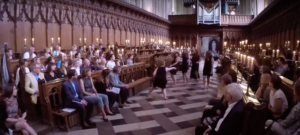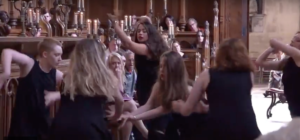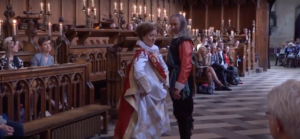This is a guest blog-post by Dr Daniel Smith of King’s College London, who was the recipient of a Malone Society Research Grant in 2016.
Staging The Masque of Queens
As part of a conference in Oxford dedicated to the pre-eminent non-royal woman patron and masque-dancer of early Stuart England, Lucy Harington Russell (1580–1627), Countess of Bedford, the Masque of Queens by Ben Jonson and Inigo Jones was staged at New College, Oxford on 11 August 2016. A grant of £800 from the Malone Society substantially covered the costs of this one-off performance, enabling us to record it for posterity and create an open-access teaching resource for academics wishing to bring the masque into their classrooms. The masque recording was completed in time to join King’s College London’s Shakespeare400 celebrations of 2016, and can be found here.
Our Masque of Queens was directed by Dr Emma Whipday (KCL/UCL), and featured professional dancers and musicians alongside a performance of the script by six actors, most of them MA students from King’s, in the stunning chapel of New College, its glorious reredos standing in for Inigo Jones’s imposing House of Fame, a principal architectural feature of the original 1609 performance. The executive producers were Dr Nadine Akkerman and Dr Daniel Smith, and the producer at New College was Rev. Dr Erica Longfellow, the college chaplain.
The performance was designed in part to show how a masque works on stage, but also to show its potential for modern-day adaptation. Whipday made some small cuts to the text, and fitted the performance’s tone the requirements of the setting and the cast. Out of term and with no advertising, the full complement of 200 free tickets were taken within 48 hours – this kind of popularity underscores the importance of having a video recording, and points to the potential success of future masque performances.
Despite the popularity of Renaissance drama today, early modern masques are hardly ever performed, since they require so many individual talents in the performers and such a range and depth of historical understanding by the directors and producers. Bringing masques back on to the stage is the best way to increase our understanding of these vividly visual and musical events. We are fortunate to have images attesting to the costume designs and sets of the Masque of Queens, as well as notes about the original make-up and Alfonso Ferrabosco’s score. The survival of such information is rare in this period and enabled us to base our performance firmly on historical evidence.
This recording enables future scholars to study two fascinating figures in seventeenth-century culture simultaneously. Ben Jonson’s outstandingly significant Workes enjoyed a quatercentenary in 2016, a year naturally dominated by events marking Shakespeare’s death. The Countess of Bedford pioneered a space on stage and in society for female creativity and political expression, but her contribution to the history of women’s stage-craft is little known beyond academic masque studies. Lady Bedford danced in more court masques than any non-royal figure and was intimately associated with this now-neglected genre. To comprehend the achievements of this pioneering woman we must understand the masque in relation to visual culture, materiality, and performance, and how these factors helped negotiate political authority and gender structures.
With The Masque of Queens performed in an ornate chapel in Oxford, and John Milton’s A Masque Presented at Ludlow Castle (aka Comus) drawing audiences at the Sam Wanamaker Playhouse in London, perhaps other directors, producers, scholars, and performers will take up the challenge of recreating the masque for twenty-first century audiences?



